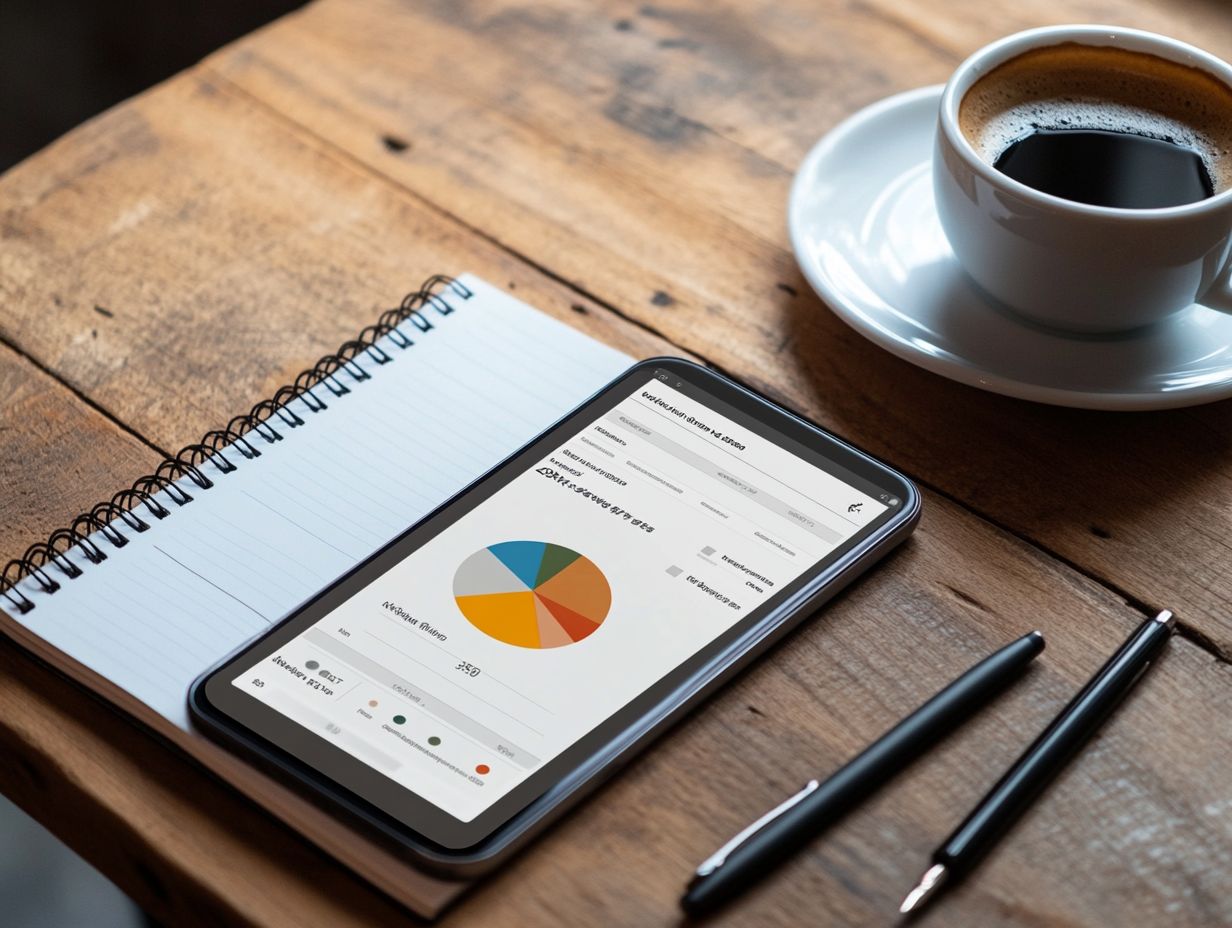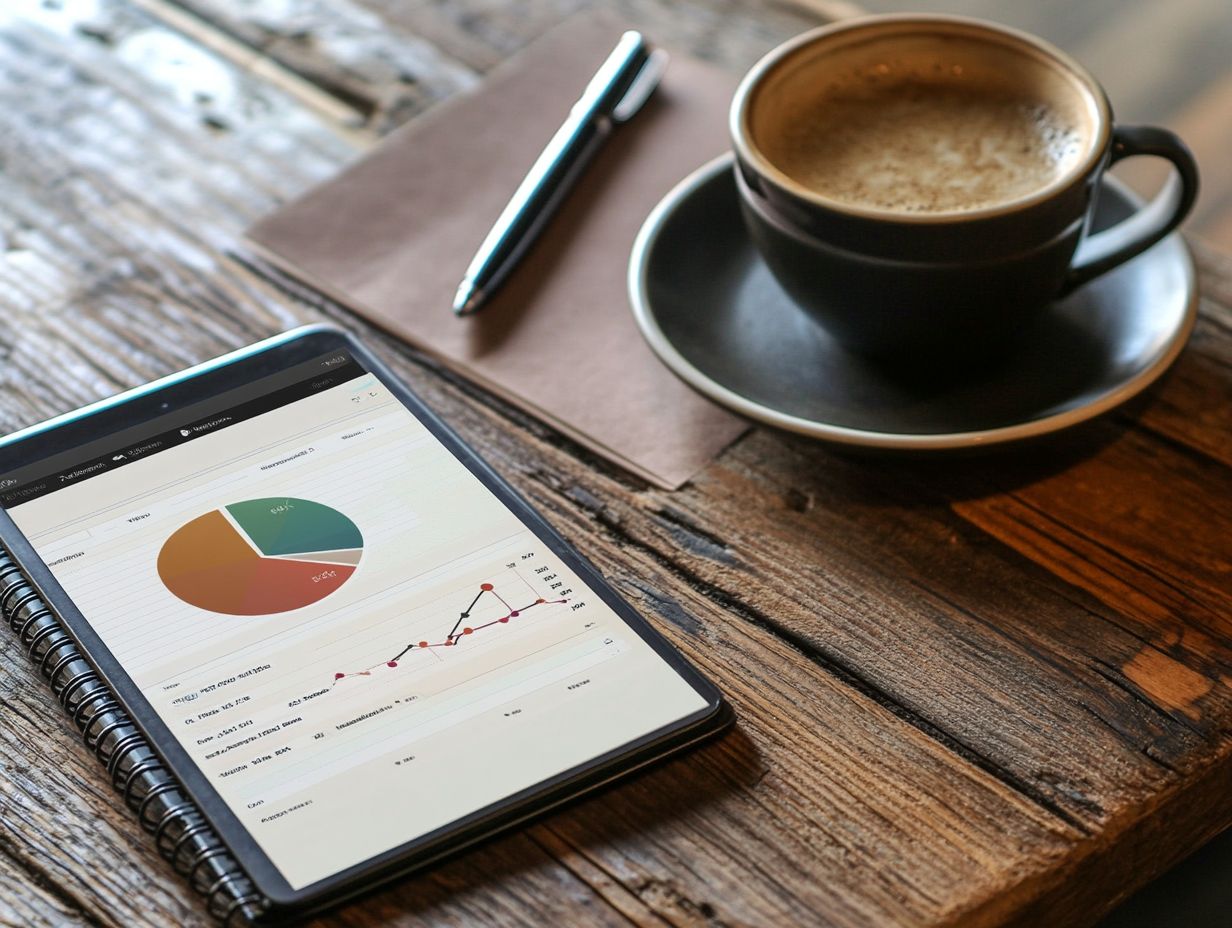How to Track Credit Card Spending?
Tracking your credit card spending goes beyond simply glancing at your purchases; it s a crucial step towards achieving financial health and stability.
By monitoring your credit card usage, you can gain valuable insights into your spending habits and steer clear of debt. This article delves into various methods, both manual and automated, and highlights useful tools and apps to enhance your tracking experience. It also addresses common pitfalls you may encounter along the way.
By the end, you ll discover how effective tracking can revolutionize your budgeting and saving strategies. Ready to transform your financial future? Let s get started!
Contents
- Key Takeaways:
- Why Track Credit Card Spending?
- Your Guide to Tracking Credit Card Spending Effectively!
- Tools and Resources for Tracking Credit Card Spending
- Tips for Effective Credit Card Tracking
- Common Mistakes to Avoid
- Using Credit Card Tracking to Improve Financial Health
- Frequently Asked Questions
- What is the best way to track my credit card spending?
- Can I track my credit card spending manually?
- What information do I need to track my credit card spending?
- How often should I track my credit card spending?
- What are the benefits of tracking my credit card spending?
- Is there a limit to how many credit cards I can track at once?
Key Takeaways:

- Monitoring credit card usage is crucial for financial stability and avoiding debt.
- Choose between manual or automated tracking methods based on your preferences and needs.
- Use budgeting apps and credit card statements to effectively track your spending and create a realistic budget.
Why Track Credit Card Spending?
Tracking your credit card spending is essential for maintaining your financial health. It enables you to clearly understand your overall expenses and make informed choices about responsible spending. By keeping an eye on your account activity, you can identify patterns, catch any errors, and align your spending habits with your financial goals, ensuring a positive cash flow.
Using budgeting apps makes tracking easier. These tools help you manage your finances and avoid overspending.
Benefits of Monitoring Credit Card Usage
Monitoring your credit card usage offers heightened awareness of your expenses and the ability to spot errors before they spiral out of control. By leveraging transaction alerts which notify you of any purchases made with your card you can maintain a keen sense of your spending and ensure it aligns seamlessly with your financial aspirations.
Keeping a vigilant eye on your accounts can significantly improve your budgeting practices, allowing you to allocate your resources with greater precision. This proactive strategy helps you thwart fraudulent transactions that could jeopardize your financial stability.
When you re informed about your payment information and spending habits, you can achieve better cash flow management, enabling you to make more strategic decisions that ultimately enhance your financial well-being.
Your Guide to Tracking Credit Card Spending Effectively!
You have a variety of methods at your disposal for tracking credit card spending, each with its own set of benefits and drawbacks.
On one hand, there’s manual tracking, which involves jotting down your expenses by hand. While this approach can be somewhat time-consuming, it grants you the opportunity for careful review of your spending patterns.
On the other hand, automated tracking using budgeting tools and credit card apps provides the convenience of real-time updates, simplifying the process and allowing you to effortlessly monitor your financial habits.
The choice ultimately hinges on your personal preference and lifestyle.
Start tracking your spending today and see how your finances can improve!
Manual Tracking vs. Automated Tracking
When you think about tracking credit card spending, manual tracking means jotting down transactions by hand. While this approach can give you a detailed understanding of your finances, it often lacks the efficiency that comes with automated tracking options.
On the flip side, automated tracking harnesses technology and apps to effortlessly summarize your credit card activity, generate expense reports, and categorize your expenses.
Manual tracking allows you to customize your financial records, but let’s face it it can be time-consuming and prone to errors. Those who opt for manual methods often gain a solid grasp of their spending habits, but they must stay vigilant about updating their records regularly.
In contrast, automated tracking methods, like those provided by apps such as Mint or YNAB (You Need A Budget), offer real-time updates and a complete view of your expenses. These tools sync automatically with your bank accounts and credit cards, enabling seamless categorization and budget creation.
However, relying too heavily on technology might cause you to overlook the finer details of your financial activities, potentially missing out on valuable opportunities for savings or investments.
Tools and Resources for Tracking Credit Card Spending

You have access to a wealth of tools designed to track your credit card spending with ease. Consider using budgeting apps like Mint, YNAB, or Expensify. These platforms streamline expense management by categorizing your transactions and offering financial insights.
Don’t forget that your credit card statements are valuable. They help you review your purchases and identify any discrepancies in your account activity.
Budgeting Apps and Credit Card Statements
Budgeting apps are essential tools for tracking your credit card spending. They enable you to categorize expenses and manage your budget effectively. Meanwhile, credit card statements provide a complete view of your account activity and spending patterns.
By integrating budgeting tools like Mint, YNAB (You Need A Budget), and Expensify with your credit card statements, you can easily sync transactions. This ensures that all your expenses are captured in real-time.
This seamless connection allows you to stay organized and in control of your spending. You ll quickly spot unnecessary purchases and make timely adjustments.
These apps often present features that provide insights into your spending habits over time. This can be crucial for developing healthier financial practices. You ll benefit from personalized financial tips and effective expense-tracking strategies, enabling you to make informed decisions that enhance your overall financial wellbeing.
Tips for Effective Credit Card Tracking
To master credit card spending, it’s essential to adopt best practices. Consider setting up mobile alerts for every transaction, establishing due date reminders for payments, and automating your payments to avoid late fees.
These strategies not only simplify tracking your expenses but also elevate your budgeting and overall financial management.
Best Practices for Accurate Tracking
Accurate tracking of credit card spending involves several best practices you should embrace:
- Regularly check receipts.
- Review purchases.
- Consistently categorize your expenses.
These actions will help you align your spending with your financial goals and maintain a clear understanding of your finances.
To further enhance your accuracy, consider establishing a routine for updating your financial records perhaps weekly. This routine should encompass logging expenditures and analyzing spending categories like dining, entertainment, and groceries.
By breaking down where your money is going, you ll quickly spot patterns that can save you money! Regularly reviewing past transactions enables you to spot discrepancies or unauthorized charges, enhancing your security.
Ultimately, this ongoing assessment and organization of your finances enable you to make informed decisions, ensuring that your expenses remain in harmony with your long-term objectives.
Start applying these tips today to take charge of your finances!
Common Mistakes to Avoid
Stay ahead of your finances by sticking to smart budgeting practices! When you track your credit card spending, it’s essential to steer clear of common missteps that could result in overspending or missed payments. Overlooking errors in transaction records or neglecting to watch for fraudulent charges can be particularly detrimental.
By following sound budgeting practices and staying alert to interest rates and payment deadlines, you can safeguard your financial well-being and maintain control over your spending habits.
Pitfalls in Credit Card Tracking and How to Avoid Them

Some common pitfalls in credit card tracking include:
- Neglecting to manage your spending regularly
- Failing to track your expenses digitally
- Overlooking important updates from your financial institution about account activity.
These missteps can create a distorted view of your financial situation, ultimately hindering responsible spending.
You may underestimate the significance of categorizing your expenses, which can prevent you from spotting spending patterns or identifying areas where you could cut back. Ignoring promotional offers or rewards can also lead to missed opportunities for maximizing your savings don’t miss out on this!
Not setting specific budgets for different spending categories can amplify financial strain. To enhance your financial management, leverage the digital tools at your disposal. By prioritizing regular reviews of your account statements and utilizing budgeting apps, you can achieve clearer insights into your financial behaviors and make more informed decisions.
Using Credit Card Tracking to Improve Financial Health
Utilizing credit card tracking effectively can greatly enhance your financial health by offering valuable insights into your spending habits and helping you with better budget management.
By implementing a range of budgeting apps and strategies, you can optimize your cash flow, set achievable savings goals, and progress steadily toward your financial aspirations.
Benefits of Tracking Your Spending
Tracking your credit card spending is essential for effective budgeting and saving. It enables you to identify spending patterns and manage your expenses thoughtfully. By learning how to use your credit card for budgeting, you can understand where your money goes and make informed decisions that align with your financial goals, ultimately enhancing your savings strategy.
When you regularly review your credit card statements, you might uncover unexpected expenditures in areas like dining out or subscription services. Recognizing these habits allows you to reevaluate your spending priorities and make more intentional choices. Utilizing budgeting apps can help you categorize your spending, enabling you to set limits in various categories.
This awareness helps you curb unnecessary expenses and paves the way toward achieving significant savings milestones. Ensuring your money works efficiently means you are taking proactive steps toward realizing your long-term financial aspirations.
Frequently Asked Questions
What is the best way to track my credit card spending?
Use a budgeting app that syncs with your credit card for easy tracking.
Can I track my credit card spending manually?

Yes, you can track credit card spending manually by keeping track of your receipts, statements, and entering the information into a spreadsheet or budgeting tool.
What information do I need to track my credit card spending?
You will need your credit card statements, receipts, and any other records of credit card transactions to track your spending.
How often should I track my credit card spending?
It is recommended to track your credit card spending at least once a week to ensure accuracy and stay on top of your expenses.
What are the benefits of tracking my credit card spending?
Tracking your credit card spending can help you stay within your budget, identify areas where you are overspending, and plan for future expenses.
Is there a limit to how many credit cards I can track at once?
Great news! You can track as many credit cards as you want.
Just make sure you have the necessary information for each one and a budget app that can handle multiple accounts. This way, you’ll stay on top of your finances!






